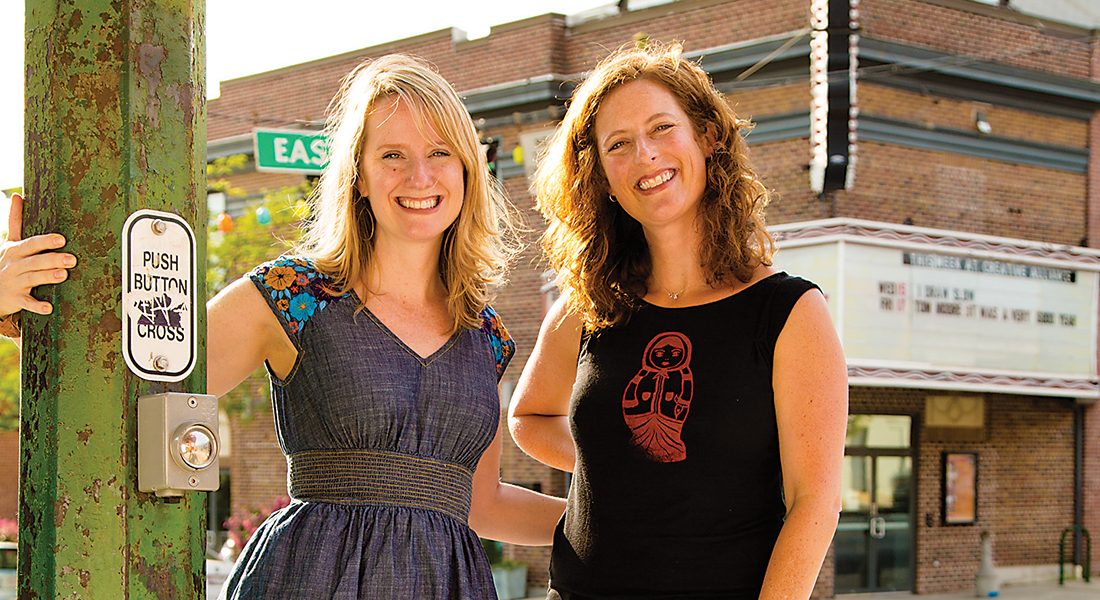Arts & Culture
Inside Story
After 10 seasons, The Stoop Storytelling Series continues to connect Baltimoreans through their most awkward, poignant, and revealing moments.
Catharine Robertson is trying not to freak out. All day, she’d told herself she wouldn’t be nervous. But now, with her lips close to a microphone, a spotlight illuminating her onstage, and a sea of hundreds of faces staring up at her, she feels it—a wave of terror.
Robertson takes a deep breath, still tasting the nip of whiskey she’d had before going on, and looks over at the woman standing next to her. “I was born in July of 1969, in Richmond, VA,” she begins, her voice breaking slightly. “And I always knew I was adopted. I never didn’t know, it was always part of my story.” The details come quickly. How Robertson learned as an adult that she’d been born with another name—Sarah—and how she’d invited friends to her house for a party just to tell them. How she’d requested records, but couldn’t find her birth mother.
It’s difficult to keep her thoughts straight, and at one point she sighs and says, “I think I lost my place.” She looks at individual people who are part of the audience at Center Stage for this Stoop Storytelling show and sees that they, too, have tears running down their cheeks. So, she gathers her will and continues.
After decades of trying, Robertson followed the trail of information to the Facebook page of the woman she believed was her mother. The crowd laughs at the irony of making the discovery on social media, when so many other methods had failed. And then it becomes clear that the woman standing next to Robertson onstage, who is sharing in the story’s telling, is her birth mother. They’d met for the first time as adults only a few months earlier.
“And we’ve been inseparable ever since,” Robertson says, as the crowd’s applause rains down on her. She glows with triumph—but more than that, she feels a connection to the people who have heard her story, cried with her, supported her, and now, presumably, understand how much this discovery means.
Connecting people and creating empathy for others’ journeys is what The Stoop Storytelling Series is all about. As the self-described “emotional midwives of Baltimore storytellers’ tales,” Laura Wexler and Jessica Henkin know this better than anyone. The Stoop’s co-founders have shepherded hundreds of Baltimoreans through revelations big and small, lighthearted and profound, for the past decade.
When they hosted the first show, on February 9, 2006, Wexler and Henkin had no expectations. In fact, they picked their first show’s theme, “Legends of the Fall: Stories of Failure,” just in case it flopped.
But it didn’t. And 10 seasons later, The Stoop remains a tried-and-true part of Baltimore culture. What gives it staying power, according to supporters and story veterans, is that the experience creates intimacy, initiates discussion, and ultimately fosters a better sense of community.
“What people are hungry for is the human connection,” says Robertson, by day a web strategist who shared this Stoop story in fall 2013. “In Baltimore, it’s especially successful because we’re underdogs, we root for underdogs, and everybody on stage is an underdog.”
The first show was “terrifying for me . . . but then it was so exhilarating.”
The Stoop’s 10th anniversary also brings its third move. The series will now be at The Senator Theatre (Center Stage, its home for eight seasons, will undergo renovations next January). The stately movie house also brings more seats—700 compared to 540—a bonus, as shows have almost always sold out. And Wexler and Henkin are keeping their topics timely this season—they’re hoping to include a show for the anniversary of Freddie Gray’s death.
The storytelling nights are a nice change of pace, says Senator co-owner Kathleen Cusack Lyon. “It’s a very minimalist and clever way to entertain,” she says. “Entertainment today can be too much—stadium seating, surround sound—and The Stoop is engaging in its simplicity.”
That simplicity is key, and one of the reasons The Stoop was ahead of its time. Now, similar series—where each show has a theme, and participants get up to tell unscripted tales from humorous yarns to poignant life moments—have sprung up in almost every state. Storytelling is a natural reaction to the globalization and constant inundation of information that social media and the Internet bring, says Kiran Sirah, president of the International Storytelling Center, located in Jonesborough, TN.
“It’s a safe way for people to come and talk about things they’re really passionate about, and to look at issues that are really pertinent in our society—racial identity, discrimination, and bullying,” Sirah says. “People are drawn also to seeing it live, that intimate moment when people can share with one another. It’s almost a kind of therapy.”
The Stoop was inspired by the storytelling techniques on National Public Radio shows such as This American Life, of which Wexler and Henkin are fans. Wexler also was inspired when she attended San Francisco’s Porchlight storytelling series in 2005. The best part, she felt, was being a part of the audience and really feeling at one with the storytellers. She’d never experienced anything like it.
So when she came back to Baltimore, where she is a writer and editor, Wexler enlisted the help of her friend Henkin, now a special education administrator with the Baltimore City Public Schools, who had experience in improv. “I thought, ‘I’m the writer part of it, and if she was the performer part of it, we would make a good team,’” Wexler says. “And she was really game to [try it once or twice]. It was a little bit like the one- or-two-night stand that turned into the marriage.”
On a recent return visit to the Creative Alliance—the art, music, and performance hub where the series began—Wexler drags out a binder and file folder, both full of memorabilia. “Look, our first program!” she says, holding up a folded, red paper. “My blood, sweat, and tears went into this,” she says, laughing as she talks about how she “designed” it, her fingers making air quotes.
It took a little effort to sell it to the community—some asked, “Is it for kids?” (Not really.) But from the beginning, the Creative Alliance was on board. To make the first show as successful as possible, Wexler and Henkin recruited local celebrities such as author Laura Lippman, who discussed getting demoted at The Sun, and WJZ-TV morning host Marty Bass, whose topic was losing his hairpiece on air.
The first show was a lesson for Wexler “in the beauty of imperfection and the authenticity that can exist when you allow for imperfection,” she says. “That first show was so terrifying for me . . . but then it was so exhilarating.”
That idea began to influence how she and Henkin structured the shows. The one run-through workshop they have with the storytellers beforehand began to be more about harnessing emotions than getting stories word-for-word. If they are expecting “to rehearse their stories over and over again, we tell them, ‘This is going to be a remarkably different experience,’” Henkin says. “We know the Baltimore audience can smell a canned performance a mile away, and you’ll get a less authentic response.”
“It’s everybody up there, and . . . people are really entertained by that.”
It was also important for those involved to understand that liquid courage was best taken in moderation (even for the three audience volunteers chosen at random to tell a three-minute story). And that the storytellers could not manipulate their tales. “We tell the storytellers, ‘We’ve made a contract with the audience, and so have you by participating, that you’re being honest, and we want to honor that contract,’” Wexler says. She notes that honesty hasn’t been a problem.
As the shows continued, Wexler and Henkin tried to remain measured and not think further than a year in advance. But it was clearly catching on, as more and more people came out, curious about the unique concept.
“These are your neighbors—your doctors, your teachers, your baristas,” says Terry Sapp, who braved the stage three times, once to tell a story about being a maid in San Francisco, and twice to talk about traveling to see the band Twisted Sister, as he is their biggest fan. “It’s everybody up there, and I think people are really entertained by that.”
Continuing to sort through memorabilia at the Creative Alliance, Wexler pulls out a story from The Sun. “And this was from our first radio program. God, we look so much younger back then,” she says.
“Yeah, the show has really aged us,” Henkin replies. Then, they both giggle.
The Stoop outgrew the Creative Alliance and moved to Center Stage in 2007. WYPR aired the stories, as well as a variety show that Wexler and Henkin produced that combined Stoop stories with scripted skits and other entertainment. The pair also presented workshops, created a “holiday spectacular” at the Joseph Meyerhoff Symphony Hall in 2008, and took the series to Columbia and Owings Mills. Now, there’s even a “Second Stoop” at The Windup Space near Station North, where anyone can tell a story.
Even with all the changes, they knew The Stoop would be nothing without storytelling. For each show, Wexler and Henkin curated the stories to ensure they had a good mix—gut-wrenching, uplifting, hilarious—and continued gathering a creative ensemble of storytellers, each with seven minutes to tell their tales. Boxer Mike “The Persecutor” Paschall talked about his first fight. Former mayor and now mayoral candidate Sheila Dixon told a story about her brother going to the bathroom in their crib.
All the while, Wexler and Henkin held day jobs, and had four children between them. Henkin jokes that she moved and changed hairstyles countless times. Their husbands maintain an active role—Wexler’s husband, Mike Subelsky, created their website and Henkin’s husband, Aaron Henkin, records the stories and often plays segments on his radio show, The Signal.
The family atmosphere isn’t lost on the patrons. Jim Karantonis, a Columbia resident and regular for a few years, says it was Wexler and Henkin’s interactions, and hilarious banter, that hooked him. He enjoyed himself so much, and felt so supported, that he eventually told stories about working as a psych tech in the Army during the Vietnam War.
“They have this way of connecting with the audience and the performers,” he says. “They relax you, and you start to realize that the audience is already on your side.”
After packing up their memorabilia from the Creative Alliance, Wexler and Henkin make their way to The Senator, their new home. They peek inside the theater between movies, as low lights illuminate the gilded curtain, and tinkling music plays softly in the background. Their voices are hushed.
“This is beautiful. Now I’m feeling scared,” Wexler says. “Wow, this is big.”
“I feel really happy!” Henkin says. “I think it’s going to be great.”
“I know, I know,” Wexler says with a cautious smile, exhibiting the pragmatism that balances Henkin’s dreamy optimism.
What the ladies didn’t expect when they started The Stoop was to forge such strong connections with Baltimoreans they normally wouldn’t have encountered. They’ve celebrated milestones—Robertson’s continued relationship with her birth mother, for example—mourned storytellers’ deaths, and reveled in recognizing people nearly everywhere they go. In a way, watching the storytellers expose themselves and their lives has brought out their mothering instincts.
“We recognize that this is a huge risk, and we want to be gentle with people,” Wexler says. “The audience is gentle, too, and you really feel that. They just want to know who these people are.”
Next season’s plans are still in the works, but Wexler begins talking of their holiday show, which will feature storytellers along with a movie—Elf? Or perhaps Die Hard?
While Wexler ponders, Henkin makes her way to the stage, and stands with her face lifted up toward the lights. She’s picturing what it will look like on October 7, when the seven storytellers take their spots behind the microphone.
Moments of Truth
The Stoop Storytelling Series founders Laura Wexler and Jessica Henkin weigh in on their favorite memories from the series’ 10 seasons. Click through to hear audio of their stories.
The Ring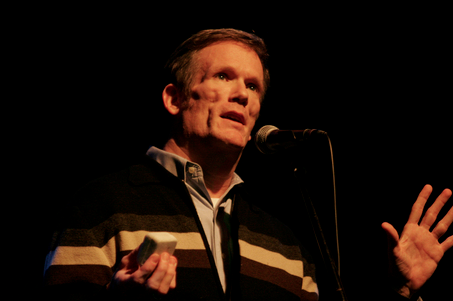
Jim Magruder, a writer, got up on stage in December 2006 to talk about the failure of his marriage. At the end, he triumphantly threw his wedding ring into the crowd. What happened after that was magic, according to Wexler and Henkin. Someone in the crowd saved the ring and brought it to the next show, where it was passed to someone new. This continued for so many Stoop shows that Wexler and Henkin lost count.
The Song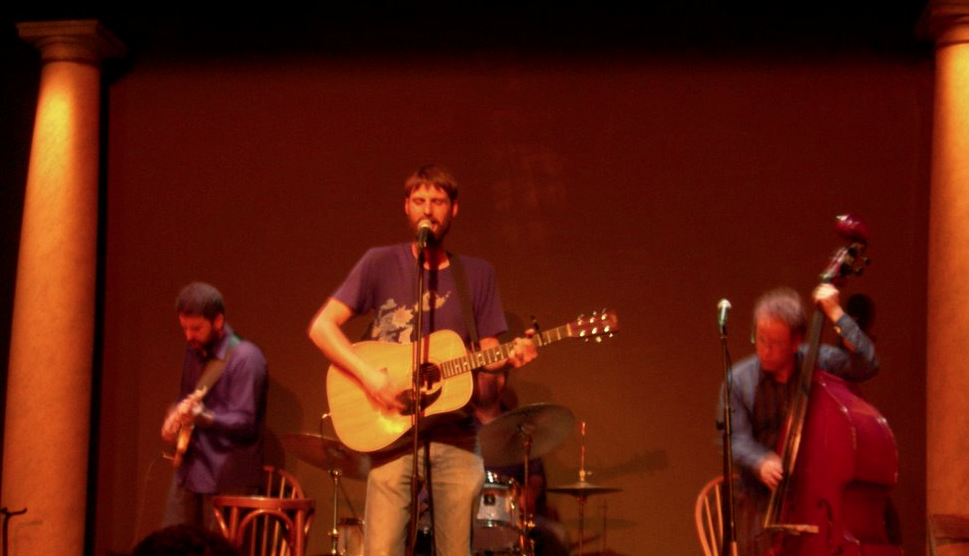
In October 2006, The Stoop held an all-male show about fear. The last story, about a fatal shark attack, left the audience in a somber mood. That is until Caleb Stine, leader of the Stoop’s house band at the time, struck up “Here Comes the Sun” on his guitar. Soon, everyone was singing along.
The Hell-Raiser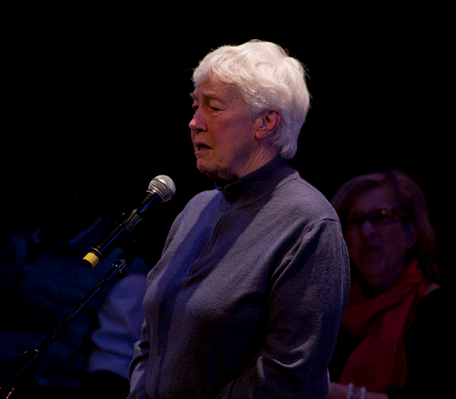
This past February, Liz McAlister described the morning she and six other anti-war activists, who were part of the Plowshares movement, were arrested when they broke into an air force base in New York, damaged and poured blood on nuclear warheads.
The Trailblazer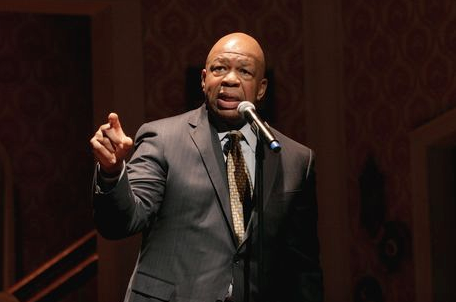
U.S. Rep. Elijah Cummings told a story about integrating the Riverside pool as a boy during a show about race in February 2010.
The Surprise Date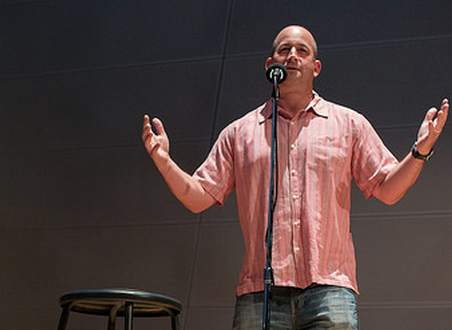
In April 2014, Greg Abel described a date with a woman who soon became infamous—Monica Lewinsky.
